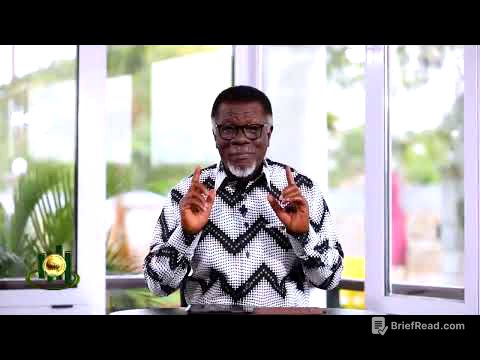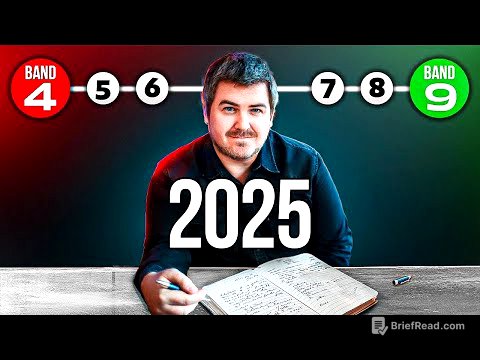TLDR;
This video presents five core principles for effective productivity, arguing that most productivity advice is impractical because it doesn't align with how the brain naturally functions. The principles include the Two-Minute Rule, energy-based scheduling, the Three-Priority System, brain dumping, and Parkinson's Law exploitation. The video emphasizes simplicity and integration of these principles for optimal results.
- The Two-Minute Rule helps clear mental clutter by immediately addressing tasks that take less than two minutes.
- Energy-based scheduling involves aligning tasks with peak energy levels for maximum efficiency.
- The Three-Priority System focuses on identifying and completing only three critical tasks per day.
- Brain dumping involves writing down all thoughts and ideas to free up mental space.
- Parkinson's Law exploitation uses short deadlines to enhance focus and efficiency.
Introduction [0:00]
The video addresses the overwhelming amount of productivity advice available, suggesting that much of it is ineffective because it's not practical or sustainable. It critiques the culture of optimizing every second, which paradoxically leads to increased overwhelm. The presenter introduces five core principles that have proven effective through extensive testing, emphasizing their alignment with the brain's natural functions rather than aspirational ideals.
Chapter 1: "Why Most Systems Fail" [1:13]
Most productivity systems fail because they are designed for ideal, robotic conditions rather than human realities. These systems assume infinite willpower, perfect consistency, and no bad days, ignoring the biological factors that influence energy levels, attention spans, and resistance to change. The video uses the analogy of a Formula 1 race car being used for a daily commute to illustrate the impracticality of complex systems. The presenter argues that the brain needs simple principles that align with its natural wiring to clear mental clutter effectively.
Chapter 2: "Principle 1: The Two-Minute Rule" [2:37]
The Two-Minute Rule involves completing any task that takes less than two minutes immediately. This principle is rooted in neuroscience and helps to reduce mental clutter. Every undone task creates an open "browser tab" in the mind, consuming mental resources. This phenomenon is known as the Zeigarnik effect, where incomplete tasks are more easily remembered than completed ones. By closing these mental tabs, the Two-Minute Rule frees up mental space and enhances focus.
Chapter 3: "The Psychology of Immediate Action" [5:36]
The brain tends to overestimate the time required for small tasks, leading to task inflation. This means that the longer a task is postponed, the larger it appears in the mind, accumulating what the presenter calls "procrastination debt." By following the Two-Minute Rule, this inflation cycle is broken, revealing that many tasks are actually quick actions in disguise. This approach reduces overwhelm and provides mental clarity, allowing for better focus on important matters.
Chapter 4: "Principle 2: Energy-Based Scheduling" [6:56]
Traditional time management is less effective than energy management. The presenter argues that not all hours are equal; individuals typically have only a few hours of peak mental energy each day. Scheduling tasks according to energy levels, rather than time, is crucial. Complex tasks should be aligned with high-energy periods, while mindless administrative tasks should be reserved for low-energy times. This strategy optimizes productivity by working with, rather than against, one's natural biological rhythms.
Chapter 5: "Finding Your Power Hours" [8:18]
Identifying personal "power hours," or times when the brain is most effective, is essential. The presenter suggests tracking energy levels hourly for a week on a scale of 1 to 10 to identify predictable patterns. Once these patterns are known, scheduling important tasks during peak energy times can significantly increase efficiency. Respecting these energy patterns allows for more to be accomplished in less time, as tasks that might take hours during low-energy periods can be completed in a fraction of the time when energy is high.
Chapter 6: "Principle 3: The Three-Priority System" [9:46]
Limiting oneself to only three priorities per day is crucial for maintaining focus and achieving meaningful progress. The presenter argues that when everything is a priority, nothing truly is, because the brain cannot effectively manage more than three main objectives at once. The Three-Priority System forces clarity by requiring the selection of three tasks that, if completed, would make the day a success. Focusing on these three priorities ensures they are completed, which is more effective than partially completing many tasks.
Chapter 7: "The Art of Saying No" [11:00]
The Three-Priority System is undermined when individuals fail to protect their chosen priorities by saying "yes" to too many other commitments. Every "yes" to a small, less important task is effectively a "no" to something more important. Saying "no" is not unkind; it is a necessary mathematical equation to protect one's priorities. The presenter suggests strategies for politely declining requests, such as offering assistance at a later time, to maintain focus on the three main priorities.
Chapter 8: "Principle 4: Brain Dump Everything" [12:11]
The brain is not designed to be a storage device, yet it is often used to hold numerous details, leading to mental exhaustion. Writing everything down, regardless of the system used, is essential for freeing up mental space. Unwritten thoughts are treated as unfinished tasks, constantly consuming mental energy. By writing these thoughts down, the brain is given permission to release them, freeing up RAM for actual thinking and reducing mental clutter.
Chapter 9: "Principle 5: Parkinson's Law Exploitation" [13:24]
Parkinson's Law states that work expands to fill the time allotted for its completion. The presenter suggests exploiting this law by giving oneself ridiculously short deadlines. This forces the brain to find efficiency and focus on what truly matters. Constraints create clarity, preventing overthinking and over-editing. The result is often better than the over-polished version produced with unlimited time.
Chapter 10: “The Integration Effect” [14:48]
The five principles are most effective when integrated, creating a productivity ecosystem where each principle supports and strengthens the others. The Two-Minute Rule clears mental clutter, freeing up energy for power hours. During these power hours, focus is placed on the three priorities, protected by saying "no" to distractions. Brain dumping prevents interruptions, and Parkinson's Law ensures tasks are completed efficiently. While using just one principle may yield some improvement, using all five creates a significant, unstoppable effect. The presenter concludes by encouraging viewers to take action and implement these principles to reclaim their time and energy.









